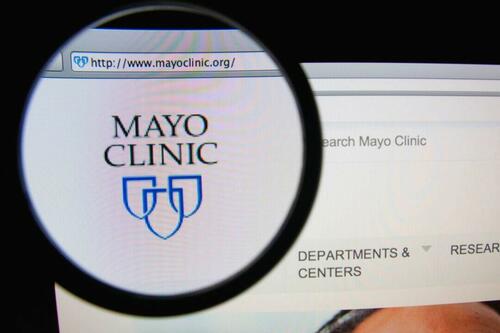
Authored by Marina Zhang via The Epoch Times (emphasis ours),
Dr. Gregory Poland, the director of Mayo Clinic’s Vaccine Research Group, has called for more rigorous detection of vaccine adverse events after suffering a COVID-19 vaccine adverse event.

“While vaccines have an overwhelmingly positive safety profile, it’s essential to address concerns about potential adverse events comprehensively and compassionately,” Dr. Poland and his co-author Dr. Steve Black of the Global Vaccine Data Network wrote in their commentary published in the journal Vaccine.
“Some of these reactions are immediate and easily observable or measurable … Others however are not immediately obvious, or are even clinically ‘silent’ or cryptic, making them challenging to identify and link directly to a vaccine.”
Dr. Poland, the lead author, suffered from what he deemed a “cryptic” adverse event.
In 2021, soon after his second Moderna shot, Dr. Poland was driving back from the clinic when he suddenly heard a whistling sound in his ears.
“It was like someone suddenly blew a dog whistle in my ear,” he told MedPage Today. “It has been pretty much unrelenting.”
He has since attributed his tinnitus to the COVID-19 vaccine and become vocal in advocating for better vaccine adverse event surveillance programs.
“It is critical to be vigilant about rare, silent, or subtle reactions. Public health agencies and healthcare providers can play a much more favorable and vital role in establishing vaccine trust by enlarging the current vaccine safety paradigm,” Dr. Poland wrote.
Spectrum of Vaccine Adverse Events
Dr. Poland said a spectrum of adverse events exists; some are easily detectable, while others are far more hidden.
Swelling at the injection site and immediate fever, for example, are immediate, easily observed, and measurable. These are thus far easier to detect and link to the vaccine if the symptoms come on soon after vaccination.
Dr. Poland reasoned that an adverse event’s detectability differs by whether it can be measured or imaged, if biomarkers are present, and if the condition is responsive to treatment.
Guillain-Barré syndrome, for example, has a long history of being associated with vaccine adverse events. The condition may be detected using a spinal tap during the acute phase and looking for elevated cerebrospinal fluid (CFS) protein levels.
Myocarditis can be detected by looking for biomarkers and taking X-rays.
Hearing loss, while it cannot be imaged or tested for using biomarkers, can be demonstrated by running hearing tests.
However, Dr. Poland considers tinnitus a cryptic adverse event since it is inherently subjective, lacks biomarkers, can be psychosomatic, and may be caused by an underlying condition other than the vaccine.
But just as tinnitus is difficult to quantify, it can also be highly disabling, Dr. Poland wrote.
React19 co-founder Dr. Joel Wallskog, who was not involved in the commentary, said that people have been driven to suicide as a result of their tinnitus. React19 is an advocacy group for those injured by COVID-19 vaccines and sufferers of long COVID.
Ways to Detect Vaccine Adverse Events
Vaccine adverse events were first detected in the earlier vaccine clinical trials. However, some adverse events were missed.
Dr. Poland gave the example of menstrual irregularities, which have been strongly linked to COVID-19 vaccines but were not reported during the vaccine trials.
“Had investigators actively solicited information on such issues or symptomatology, it would have been detected and quantifiable,” he wrote.
He also suggested monitoring new symptoms discussed on social media to detect possible trends. This may help detect new symptoms that people have not yet linked to the vaccine.
After a vaccine rolls out, average citizens can report their adverse events to the Vaccine Adverse Event Reporting System (VAERS) managed by the U.S. Centers for Disease Control and Prevention (CDC).
VAERS is a public database that allows anyone to check and report a vaccine adverse event. The system also has interventions put in place to reduce false reporting. For instance, the lengthy reporting process deters false reports. It is also a direct violation of federal law to make a false report, and those caught doing this may be fined or even imprisoned.
“Most adverse reactions are transient and self-limiting, although some may be serious or life-threatening. In my experience, however, even ‘transient’ conditions such as facial palsy may extend for months, if not years,” dentist and professor Dr. Nicola Cirillo at the University of Melbourne said in a statement on oral-facial adverse events post-COVID vaccine.
“It is important to inform vaccine recipients about these possible consequences,” he added.
Hundreds of Adverse Events Linked to COVID-19 Vaccines
Since July 2022, Freedom of Information Act-released documents from the CDC showed at least 770 safety signals have been detected by CDC researchers in the VAERS database.
These include myocarditis, tinnitus, death, and increased instances of health checkups.
Dr. Wallskog said that many VAERS reports have also become hidden.
In 2022, React19 surveyed 126 people who submitted VAERS reports. It found that only around 60 percent of VAERS reports are made available to the public.
Twelve percent of the VAERS reports were deleted, and 22 percent do not have permanent IDs and, therefore, could not be accessed by the public. The remaining 5 percent of would-be VAERS reporters could not file a report, or their report numbers were unknown.
Dr. Peter McCullough, cardiologist and a vocal critic of the COVID-19 vaccines, expressed disappointment that authors Drs. Poland and Black said that vaccines have an “overwhelmingly positive safety profile” in their conclusion, adding that safety data systems have recorded injuries, disabilities, and deaths related to the COVID vaccines.
Authored by Marina Zhang via The Epoch Times (emphasis ours),
Dr. Gregory Poland, the director of Mayo Clinic’s Vaccine Research Group, has called for more rigorous detection of vaccine adverse events after suffering a COVID-19 vaccine adverse event.

“While vaccines have an overwhelmingly positive safety profile, it’s essential to address concerns about potential adverse events comprehensively and compassionately,” Dr. Poland and his co-author Dr. Steve Black of the Global Vaccine Data Network wrote in their commentary published in the journal Vaccine.
“Some of these reactions are immediate and easily observable or measurable … Others however are not immediately obvious, or are even clinically ‘silent’ or cryptic, making them challenging to identify and link directly to a vaccine.”
Dr. Poland, the lead author, suffered from what he deemed a “cryptic” adverse event.
In 2021, soon after his second Moderna shot, Dr. Poland was driving back from the clinic when he suddenly heard a whistling sound in his ears.
“It was like someone suddenly blew a dog whistle in my ear,” he told MedPage Today. “It has been pretty much unrelenting.”
He has since attributed his tinnitus to the COVID-19 vaccine and become vocal in advocating for better vaccine adverse event surveillance programs.
“It is critical to be vigilant about rare, silent, or subtle reactions. Public health agencies and healthcare providers can play a much more favorable and vital role in establishing vaccine trust by enlarging the current vaccine safety paradigm,” Dr. Poland wrote.
Spectrum of Vaccine Adverse Events
Dr. Poland said a spectrum of adverse events exists; some are easily detectable, while others are far more hidden.
Swelling at the injection site and immediate fever, for example, are immediate, easily observed, and measurable. These are thus far easier to detect and link to the vaccine if the symptoms come on soon after vaccination.
Dr. Poland reasoned that an adverse event’s detectability differs by whether it can be measured or imaged, if biomarkers are present, and if the condition is responsive to treatment.
Guillain-Barré syndrome, for example, has a long history of being associated with vaccine adverse events. The condition may be detected using a spinal tap during the acute phase and looking for elevated cerebrospinal fluid (CFS) protein levels.
Myocarditis can be detected by looking for biomarkers and taking X-rays.
Hearing loss, while it cannot be imaged or tested for using biomarkers, can be demonstrated by running hearing tests.
However, Dr. Poland considers tinnitus a cryptic adverse event since it is inherently subjective, lacks biomarkers, can be psychosomatic, and may be caused by an underlying condition other than the vaccine.
But just as tinnitus is difficult to quantify, it can also be highly disabling, Dr. Poland wrote.
React19 co-founder Dr. Joel Wallskog, who was not involved in the commentary, said that people have been driven to suicide as a result of their tinnitus. React19 is an advocacy group for those injured by COVID-19 vaccines and sufferers of long COVID.
Ways to Detect Vaccine Adverse Events
Vaccine adverse events were first detected in the earlier vaccine clinical trials. However, some adverse events were missed.
Dr. Poland gave the example of menstrual irregularities, which have been strongly linked to COVID-19 vaccines but were not reported during the vaccine trials.
“Had investigators actively solicited information on such issues or symptomatology, it would have been detected and quantifiable,” he wrote.
He also suggested monitoring new symptoms discussed on social media to detect possible trends. This may help detect new symptoms that people have not yet linked to the vaccine.
After a vaccine rolls out, average citizens can report their adverse events to the Vaccine Adverse Event Reporting System (VAERS) managed by the U.S. Centers for Disease Control and Prevention (CDC).
VAERS is a public database that allows anyone to check and report a vaccine adverse event. The system also has interventions put in place to reduce false reporting. For instance, the lengthy reporting process deters false reports. It is also a direct violation of federal law to make a false report, and those caught doing this may be fined or even imprisoned.
“Most adverse reactions are transient and self-limiting, although some may be serious or life-threatening. In my experience, however, even ‘transient’ conditions such as facial palsy may extend for months, if not years,” dentist and professor Dr. Nicola Cirillo at the University of Melbourne said in a statement on oral-facial adverse events post-COVID vaccine.
“It is important to inform vaccine recipients about these possible consequences,” he added.
Hundreds of Adverse Events Linked to COVID-19 Vaccines
Since July 2022, Freedom of Information Act-released documents from the CDC showed at least 770 safety signals have been detected by CDC researchers in the VAERS database.
These include myocarditis, tinnitus, death, and increased instances of health checkups.
Dr. Wallskog said that many VAERS reports have also become hidden.
In 2022, React19 surveyed 126 people who submitted VAERS reports. It found that only around 60 percent of VAERS reports are made available to the public.
Twelve percent of the VAERS reports were deleted, and 22 percent do not have permanent IDs and, therefore, could not be accessed by the public. The remaining 5 percent of would-be VAERS reporters could not file a report, or their report numbers were unknown.
Dr. Peter McCullough, cardiologist and a vocal critic of the COVID-19 vaccines, expressed disappointment that authors Drs. Poland and Black said that vaccines have an “overwhelmingly positive safety profile” in their conclusion, adding that safety data systems have recorded injuries, disabilities, and deaths related to the COVID vaccines.
Loading…





